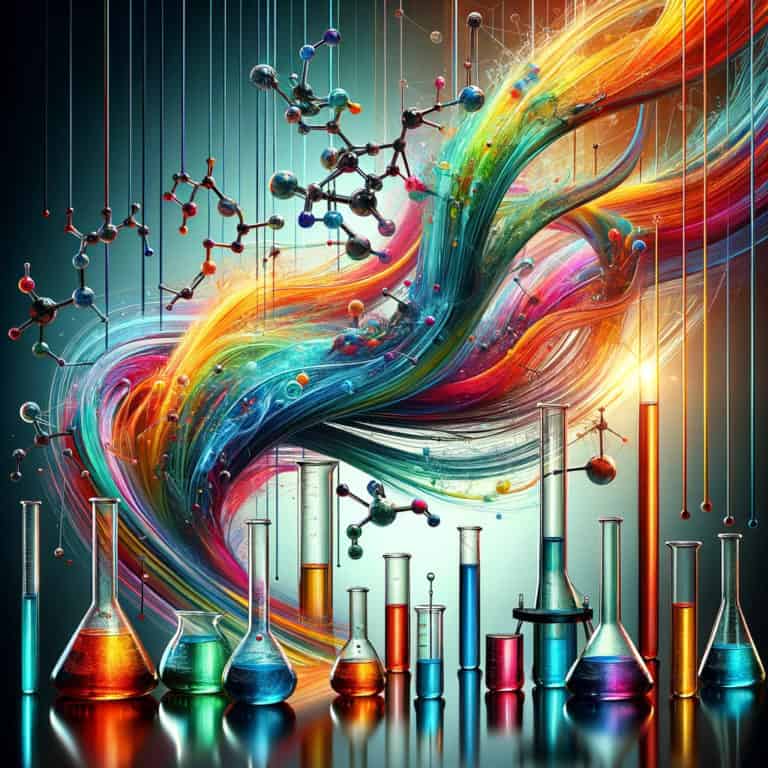Ionic Liquids Unveiled: Pioneering Sustainable Solutions in Modern Chemistry
This review delves into ionic liquids, highlighting their revolutionary uses in green chemistry and catalysis, as well as addressing difficulties and anticipating future advances in their use and environmental impact.

Introduction to Ionic Liquids
Ionic liquids are a type of solvent that has received a lot of attention in chemistry due to their unusual features and versatility. Unlike traditional organic solvents, ionic liquids have several advantages, including low vapor pressure, a wide liquid temperature range, non-flammability, high thermal and chemical stability, high ionic conductivity, and the ability to dissolve a wide range of solutes (Lan & Koo, 2013). These qualities make them suitable for a wide range of applications.
The adjustable nature of ionic liquids, which are made up of diverse combinations of cations and anions, allows them to be tailored to individual requirements (Zamir et al., 2021). This adaptability has resulted in the creation of designer solvents known as “task-specific” ionic liquids, in which physical properties such as melting temperature, viscosity, and miscibility with other solvents can be modified. Furthermore, ionic liquids’ strong ionic conductivity, low vapor pressure, good thermal stability, and broad electrochemical stability window make them appealing for use in catalysis, extraction, electrochemistry, and biotechnology (Egorova et al., 2017).
Ionic liquids are also used in hydrometallurgy as ecologically acceptable solvents due to their endurance and low toxicity (Park et al., 2014). Furthermore, in analytical chemistry, ionic liquids have emerged as potential liquid media due to their unique properties such as low vapor pressure, chemical and electrochemical stability, and distinct ionic solvation environment (Nishi, 2020).
The evolution of ionic liquid research has included the investigation of their interactions with molecules, such as when used as stationary phases in gas chromatography (Armstrong et al., 1999). According to studies, the long-range Coulombic forces seen in ionic liquids prevent ions from escaping into the gas phase, making them suited for this use. Furthermore, the design and application of functionalized ionic liquids has opened up new opportunities, such as the creation of dual-functionalized ionic liquids with improved properties (Fei et al., 2006).
Ionic liquids’ characteristics and versatility have made them attractive solvents with applications in a wide range of chemistry. Their distinguishing features, adjustable nature, and compatibility with many processes make them an important area of research and innovation in modern chemistry.
Applications of Ionic Liquids
Ionic liquids have been widely used in a variety of chemical processes, particularly catalysis, green chemistry, and solvent systems. In the chemical industry, ionic liquids have been used in a variety of processes, as mentioned in a review by Plechkova and Seddon (2008). These applications include green industrial processes, which use ionic liquids’ unique features to achieve sustainable and efficient chemical transformations.
Catalysis is a key application of ionic liquids, where they have been employed as reaction media and catalysts due to their adjustable nature and compatibility with various processes. The use of ionic liquids in catalysis has resulted in improvements in energy conversion processes, catalytic systems, and synthetic methods (Egorova and Ananikov, 2014). Furthermore, supported ionic liquid catalysis has evolved as a novel concept that combines the benefits of ionic liquid media with solid support materials, allowing the use of fixed-bed technology while minimizing the volume of ionic liquid required (Mehnert et al., 2002).
In green chemistry, ionic liquids have been used in a variety of processes, including chemical demulsification (Hassanshahi et al., 2020), carbon dioxide capture (Pinto et al., 2013), and sustainable chemical waste management. These applications demonstrate the potential of ionic liquids as ecologically acceptable alternatives to traditional solvents and chemicals, thereby contributing to the development of chemical industry sustainability practices.
Furthermore, ionic liquids have been used in solvent systems for wood dissolution (Kilpeläinen et al., 2007), chemical reaction monitoring (Khemchyan et al., 2013), and organic vapor detection (Liang et al., 2002). Ionic liquids’ capacity to dissolve a wide range of chemicals, their tunable toxicity, storage qualities, and usage in analytical procedures illustrate their versatility and relevance in various chemical processes.
Ionic liquids’ unique physicochemical features have made them essential instruments in catalysis, green chemistry, and solvent systems, providing creative solutions for a wide range of chemical industry applications.
Challenges and Future Perspectives
The use of ionic liquids presents several problems, which are now being investigated through ongoing research activities. One notable drawback is the high viscosity of ionic liquids, which reduces their usefulness in applications such as lithium-ion battery electrolytes Nirmale et al. (2018). The high viscosity of ionic liquids impedes ion movement and reduces their efficiency in several operations. Furthermore, the limited solubility of certain metal salts in ionic liquids poses a practical barrier in applications such as electrodeposition operations (Wu et al., 2014), limiting the use of ionic liquids in certain metal-related processes.
Another problem in the use of ionic liquids is the slow mass transfer of substrates into the viscous melt, which can limit reaction rates and reduce overall process efficiency (Steinrück and Wasserscheid, 2014). This constraint affects the use of ionic liquids in catalysis and other reaction processes that require effective mass transfer. Furthermore, the high viscosity of ionic liquids in typical gas-liquid contactors causes mass transfer resistance and poor gas-liquid mass transfer rates, which impede large-scale implementations of continuous CO2 capture systems (Zhang et al., 2011). Improving mass transfer characteristics is critical for increasing the efficiency of operations using ionic liquids.
Furthermore, the restricted ionicity of some protic ionic liquids raises questions about their designation as true ionic liquids, as well as conductivity and performance issues (Klapatiuk et al., 2020). Understanding and resolving the reasons that contribute to restricted ionicity is critical for improving the properties and uses of these ionic liquids. Furthermore, simple metal salts’ low solubility in most ionic liquids suited for electrodeposition processes limits their practical application in this field (Schaltin et al., 2011).
To address these obstacles and develop the subject of ionic liquids, current research focuses on topics such as systematic design of ionic liquids using ab initio calculations to tailor their physical properties to specific applications (Turner et al., 2003). Furthermore, studies on the thermal, electrochemical, and radiolytic stabilities of ionic liquids are providing insights into how to improve their stability and performance (Xue et al., 2018). Furthermore, new electrodeposition techniques based on cationic cuprous organic compounds in ionic liquids are being investigated for high current density electroplating applications (Schaltin et al., 2011).
To summarize, while ionic liquids have unique features and numerous uses, overcoming difficulties such as viscosity, mass transfer, solubility, and ionicity is critical for their broad use. Ongoing research into design, stability, and application-specific alterations is laying the way for future advances in the field of ionic liquids.
References
Armstrong, D., He, L., & Liu, Y. (1999). Examination of ionic liquids and their interaction with molecules, when used as stationary phases in gas chromatography. Analytical Chemistry, 71(17), 3873-3876. https://doi.org/10.1021/ac990443p
Egorova, K., Gordeev, E., & Ananikov, V. (2017). Biological activity of ionic liquids and their application in pharmaceutics and medicine. Chemical Reviews, 117(10), 7132-7189. https://doi.org/10.1021/acs.chemrev.6b00562
Fei, Z., Geldbach, T., Zhao, D., & Dyson, P. (2006). From dysfunction to bis‐function: on the design and applications of functionalised ionic liquids. Chemistry – A European Journal, 12(8), 2122-2130. https://doi.org/10.1002/chem.200500581
Hawker, R., Panchompoo, J., Aldous, L., & Harper, J. (2016). Novel chloroimidazolium‐based ionic liquids: synthesis, characterisation and behaviour as solvents to control reaction outcome. Chempluschem, 81(6), 574-583. https://doi.org/10.1002/cplu.201600099
Lan, N. and Koo, Y. (2013). Compatibility of ionic liquids with enzymes., 257-273. https://doi.org/10.1007/978-94-007-7711-8_10
Nishi, N. (2020). Ionic liquids as liquid materials for analytical chemistry. Analytical Sciences, 36(1), 1-2. https://doi.org/10.2116/analsci.highlights2001
Park, J., Jung, Y., Kusumah, P., Lee, J., Kwon, K., & Lee, C. (2014). Application of ionic liquids in hydrometallurgy. International Journal of Molecular Sciences, 15(9), 15320-15343. https://doi.org/10.3390/ijms150915320
Poole, C. and Poole, S. (2011). Ionic liquid stationary phases for gas chromatography. Journal of Separation Science, 34(8), 888-900. https://doi.org/10.1002/jssc.201000724
Zamir, A., Elraies, K., Rasool, M., Ahmad, M., Ayoub, M., Abbas, M., … & Ali, I. (2021). Influence of alkyl chain length in ionic liquid based drilling mud for rheology modification: a review. Journal of Petroleum Exploration and Production Technology, 12(2), 485-492. https://doi.org/10.1007/s13202-021-01343-7
Berrod, Q., Ferdeghini, F., Zanotti, J., Judeinstein, P., Lairez, D., Sakai, V., … & Constantin, D. (2017). Ionic liquids: evidence of the viscosity scale-dependence. Scientific Reports, 7(1). https://doi.org/10.1038/s41598-017-02396-7
Egorova, K. and Ananikov, V. (2014). Toxicity of ionic liquids: eco(cyto)activity as complicated, but unavoidable parameter for task‐specific optimization. Chemsuschem, 7(2), 336-360. https://doi.org/10.1002/cssc.201300459
Hassanshahi, N., Hu, G., & Li, J. (2020). Application of ionic liquids for chemical demulsification: a review. Molecules, 25(21), 4915. https://doi.org/10.3390/molecules25214915
Khemchyan, L., Khokhlova, E., Seitkalieva, M., & Ananikov, V. (2013). Efficient sustainable tool for monitoring chemical reactions and structure determination in ionic liquids by esi‐ms. Chemistryopen, 2(5-6), 208-214. https://doi.org/10.1002/open.201300022
Kilpeläinen, I., Xie, H., King, A., Granström, M., Heikkinen, S., & Argyropoulos, D. (2007). Dissolution of wood in ionic liquids. Journal of Agricultural and Food Chemistry, 55(22), 9142-9148. https://doi.org/10.1021/jf071692e
Liang, C., Yuan, C., Warmack, R., Barnes, C., & Dai, S. (2002). Ionic liquids: a new class of sensing materials for detection of organic vapors based on the use of a quartz crystal microbalance. Analytical Chemistry, 74(9), 2172-2176. https://doi.org/10.1021/ac011007h
Mehnert, C., Cook, R., Dispenziere, N., & Afeworki, M. (2002). Supported ionic liquid catalysis − a new concept for homogeneous hydroformylation catalysis. Journal of the American Chemical Society, 124(44), 12932-12933. https://doi.org/10.1021/ja0279242
Pinto, A., Rodríguez, H., Colón, Y., Arce, A., & Soto, A. (2013). Absorption of carbon dioxide in two binary mixtures of ionic liquids. Industrial & Engineering Chemistry Research, 52(17), 5975-5984. https://doi.org/10.1021/ie303238h
Plechkova, N. and Seddon, K. (2008). Applications of ionic liquids in the chemical industry. Chemical Society Reviews, 37(1), 123-150. https://doi.org/10.1039/b006677j
Seitkalieva, M., Kashin, A., Egorova, K., & Ananikov, V. (2017). Ionic liquids as tunable toxicity storage media for sustainable chemical waste management. Acs Sustainable Chemistry & Engineering, 6(1), 719-726. https://doi.org/10.1021/acssuschemeng.7b03036
Klapatiuk, D., Johnson, K., & East, A. (2020). Limited ionicity in protic ionic liquids: organic acid/trialkylamine mixtures. Ecs Transactions, 98(10), 149-159. https://doi.org/10.1149/09810.0149ecst
Nirmale, T., Khupse, N., Gore, R., Ambekar, J., Kulkarni, M., Varma, A., … & Kale, B. (2018). Ethoxy‐ester functionalized imidazolium based ionic liquids for lithium ion batteries. Chemistryselect, 3(22), 6255-6261. https://doi.org/10.1002/slct.201800513
Schaltin, S., Brooks, N., Binnemans, K., & Fransaer, J. (2011). Electrodeposition from cationic cuprous organic complexes: ionic liquids for high current density electroplating. Journal of the Electrochemical Society, 158(1), D21. https://doi.org/10.1149/1.3512905
Steinrück, H. and Wasserscheid, P. (2014). Ionic liquids in catalysis. Catalysis Letters, 145(1), 380-397. https://doi.org/10.1007/s10562-014-1435-x
Turner, E., Pye, C., & Singer, R. (2003). Use of ab initio calculations toward the rational design of room temperature ionic liquids. The Journal of Physical Chemistry A, 107(13), 2277-2288. https://doi.org/10.1021/jp021694w
Wu, T., Huang, Q., Li, W., Chen, G., Ma, X., & Guo-ping, Z. (2014). Electroreduction of copper dichloride powder to copper nanoparticles in an ionic liquid. Journal of Nanomaterials, 2014, 1-6. https://doi.org/10.1155/2014/751424
Xue, Z., Qin, L., Jiang, J., Mu, T., & Gao, G. (2018). Thermal, electrochemical and radiolytic stabilities of ionic liquids. Physical Chemistry Chemical Physics, 20(13), 8382-8402. https://doi.org/10.1039/c7cp07483b
Zhang, L., Wang, J., Xiang, Y., Zeng, X., & Chen, J. (2011). Absorption of carbon dioxide with ionic liquid in a rotating packed bed contactor: mass transfer study. Industrial & Engineering Chemistry Research, 50(11), 6957-6964. https://doi.org/10.1021/ie1025979



